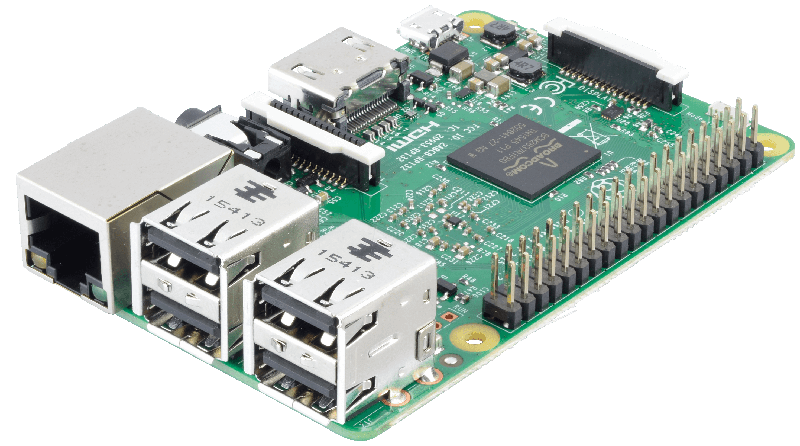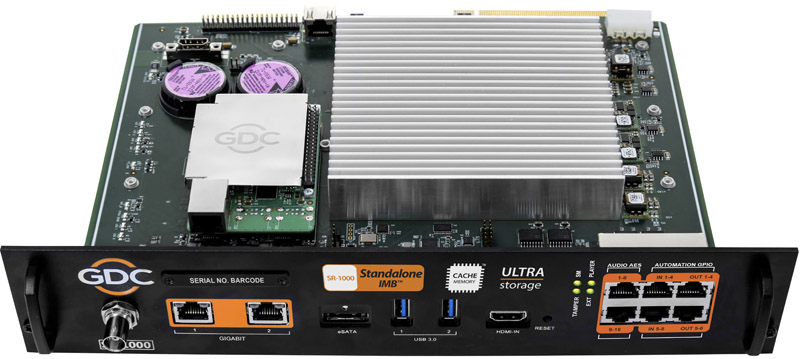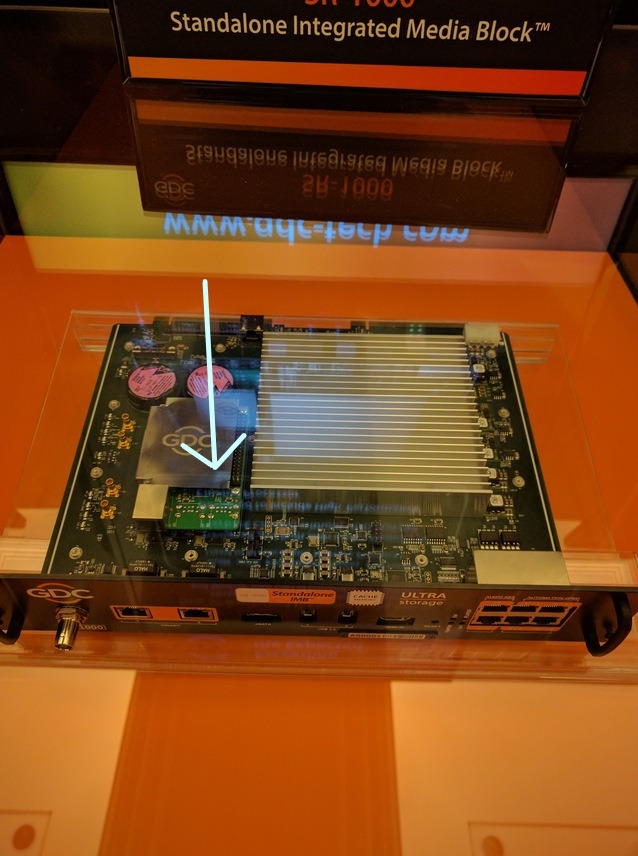|
|
This topic comprises 3 pages: 1 2 3
|
|
Author
|
Topic: IMB with Raspberry PI
|
|
|
|
|
|
|
|
|
|
|
|
|
Carsten Kurz
Film God
Posts: 4340
From: Cologne, NRW, Germany
Registered: Aug 2009
|
 posted 08-04-2017 08:14 PM
posted 08-04-2017 08:14 PM




You can see that this IMB Photo lacks the internal cabling, e.g. between the front HDMI port, and the HDMI port in the back, and there are two Ethernet sockets as well, one of them is probably forwarded to the PI Ethernet port, the other goes to the back close to the MediaBlock heat sink. I guess the PI is just a quick solution to setup a decent GUI and communications. I don't think it will even touch the DCP data during transfer or playout, it is not fast enough. I wouldn't call it a hack, it's a pragmatic solution. You get a cheap embedded system and the OS for free. Then again, we don't know wether the PI will stay there when this IMB is manufactured in numbers.
- Carsten
| IP: Logged
|
|
|
|
|
|
|
|
|
|
Marcel Birgelen
Film God
Posts: 3357
From: Maastricht, Limburg, Netherlands
Registered: Feb 2012
|
 posted 08-05-2017 07:03 PM
posted 08-05-2017 07:03 PM




quote: Carsten Kurz
I wouldn't call it a hack, it's a pragmatic solution. You get a cheap embedded system and the OS for free. Then again, we don't know wether the PI will stay there when this IMB is manufactured in numbers.
Yeah, pragmatic solution or a hack, the difference is in the details, if there are. ![[Wink]](wink.gif)
There's no way to get any form of commitment if the Pi3B will still be available in even a few months time. It could've been replaced with a Pi3C or Pi4, with totally different specs and connector layout for example.
Obviously you face similar challenges if you design your own PCBs from scratch, but in most cases the supplier of the individual components, usually gives you a pretty clear overview of the life cycle of the product.
quote: Pietro Clarici
I just don't get how it would interface with the internal cache/flash storage subsystem, given that it only has USB 2.0 and Fast Ethernet.
That's my problem too, the Ethernet interface is just a Fast Ethernet port, so it does 100 MBit at max, which is fine for most IPC purposes, but not something that handles DCP content in real-time in any way or form. USB 2.0 isn't doing any better. So, I guess it will be there as a form of an UI frontend, not to process any actual content, even not as a "NAS".
quote: Mark Gulbrandsen
Which Broadcom and for what purpose? Broadcom makes a lot of different processors...
The BCM2837, which is a quad-core 64-bit ARM-based CPU. You can obviously just integrate them on your own PCB.
| IP: Logged
|
|
|
|
|
|
Ioannis Syrogiannis
Expert Film Handler
Posts: 147
From: Reykjavík, Iceland
Registered: Jun 2005
|
 posted 08-06-2017 03:50 AM
posted 08-06-2017 03:50 AM




quote: Pietro Clarici
The Pi could also be field-replaceable in case of failure, while an onboard SOC would require a full IMS change.
I wouldn't depend on field-replaceability of customized hardware. But then again, I can't say what is soldered down and what is not by the pictures above.
quote: Mark Gulbrandsen
GDC tech support led us through checking the RAM and some other stuff. The drives showed they were ok. If that was a Dolby Server they would have said too bad like on the DSP-100...
If it was a DSP-100 (DSS employ the HDDs), they probably would, since they passed the support on to another company for some years now.
As for the DSS200 and DSS220, I have been instructed to run RAM checks in the past, and I was lucky to find the culprit.
Now, for "some other stuff", I wouldn't know. Yet I -for one- can't complain about the European support of Dolby, whether it has to do with original Dolby SMSs or with its (French part of) doremi-turned-Dolby ones.
I am in favor of implementing widely tested and available components in an industrial system. I wouldn't know, though if the limitations (mentioned above, or other) of such equipment, designed for micro-computing, would cause strains on the usability of the whole system. For instance, I wouldn't appreciate a non-gigabit ethernet port to serve as a control (nor data) network adapter.
Carsten might be right about missing connectivity, though.
The Ethernet port on the back of the board might be irrelevant to the two ports on the faceplate and serve as a bridge between the Fast Ethernet port of Raspberry π 3 and the rest of the system. It might be that the GPIO is custom connected to the main board on the bottom of it ![[Confused]](confused.gif) or that it is working in a similar manner to the USB drive that was implemented in the doremi DCP2000/DCP2K4/SV3/SV4, where it was just used for hosting the operating system, without posing limitations to the RAID, USB or MB functionality. The difference being that in the doremi case, the same CPU was in charge of the whole system, here you'd have a "system on a chip" to play manager with all other components. (But, hay, what about integrated wi-fi connectivity? That could be a plus, no? On the other hand, so it would be if those SDI interfaces on the left of the board were available on the faceplate... One has to dream big. or that it is working in a similar manner to the USB drive that was implemented in the doremi DCP2000/DCP2K4/SV3/SV4, where it was just used for hosting the operating system, without posing limitations to the RAID, USB or MB functionality. The difference being that in the doremi case, the same CPU was in charge of the whole system, here you'd have a "system on a chip" to play manager with all other components. (But, hay, what about integrated wi-fi connectivity? That could be a plus, no? On the other hand, so it would be if those SDI interfaces on the left of the board were available on the faceplate... One has to dream big. ![[Smile]](smile.gif) ) )
| IP: Logged
|
|
|
|
All times are Central (GMT -6:00)
|
This topic comprises 3 pages: 1 2 3
|
Powered by Infopop Corporation
UBB.classicTM
6.3.1.2
The Film-Tech Forums are designed for various members related to the cinema industry to express their opinions, viewpoints and testimonials on various products, services and events based upon speculation, personal knowledge and factual information through use, therefore all views represented here allow no liability upon the publishers of this web site and the owners of said views assume no liability for any ill will resulting from these postings. The posts made here are for educational as well as entertainment purposes and as such anyone viewing this portion of the website must accept these views as statements of the author of that opinion
and agrees to release the authors from any and all liability.
|

 Home
Home
 Products
Products
 Store
Store
 Forum
Forum
 Warehouse
Warehouse
 Contact Us
Contact Us




 Printer-friendly view of this topic
Printer-friendly view of this topic









![[Wink]](wink.gif)

![[Confused]](confused.gif) or that it is working in a similar manner to the USB drive that was implemented in the doremi DCP2000/DCP2K4/SV3/SV4, where it was just used for hosting the operating system, without posing limitations to the RAID, USB or MB functionality. The difference being that in the doremi case, the same CPU was in charge of the whole system, here you'd have a "system on a chip" to play manager with all other components. (But, hay, what about integrated wi-fi connectivity? That could be a plus, no? On the other hand, so it would be if those SDI interfaces on the left of the board were available on the faceplate... One has to dream big.
or that it is working in a similar manner to the USB drive that was implemented in the doremi DCP2000/DCP2K4/SV3/SV4, where it was just used for hosting the operating system, without posing limitations to the RAID, USB or MB functionality. The difference being that in the doremi case, the same CPU was in charge of the whole system, here you'd have a "system on a chip" to play manager with all other components. (But, hay, what about integrated wi-fi connectivity? That could be a plus, no? On the other hand, so it would be if those SDI interfaces on the left of the board were available on the faceplate... One has to dream big. ![[Smile]](smile.gif) )
)



